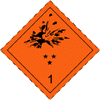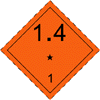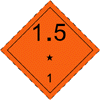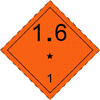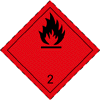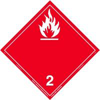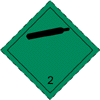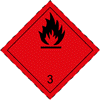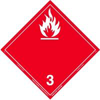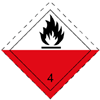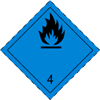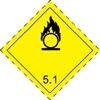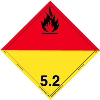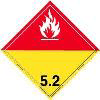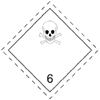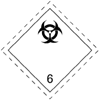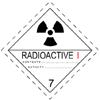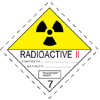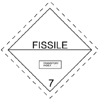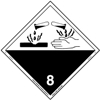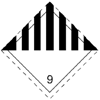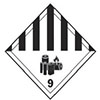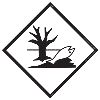- Dangerous Goods Notification System
- DG Manifest Submission via eBS
- Labels and Classification of DG in IMDG Code
- Regulation of DG in Hong Kong Waters
- Contacts for Enquiries
- Frequency Asked Questions
Dangerous Goods Declaration
General Information
Labels and Classification of Dangerous Goods in International Maritime Dangerous Goods Code (IMDG Code)
Numerals shall be about 30 mm in height and be about 5 mm thick (for a label measuring 100 mm by 100 mm). Figure "1' in bottom corner.
** Place for division – to be left blank if explosive is the subsidiary risk.
* Place for compatibility group – to be left blank if explosive is the subsidiary risk.
* Place for compatibility group
Regulation of Dangerous Goods in Hong Kong Waters
General
Dangerous goods transported by sea means:
- any substance or article falling within a class in the IMDG Code or any other IMO publication as dangerous in nature; and
- any other substance or goods the properties of which might be dangerous if such substance or goods, including empty receptacles, and residues in empty tanks or cargo holds, which have been used previously for the carriage of dangerous goods, except where such receptacles, empty tanks or cargo holds have been:
- cleaned and dried;
- gas freed or ventilated where appropriate; or
- if the previous contents were radioactive, cleaned and adequately closed,
This Unit is responsible for:
- regulating the conveyance of dangerous goods at sea within Hong Kong waters; and
- carrying out random physical check on vessels having or not having onboard dangerous goods to ensure that the relevant code and regulations, such as the Dangerous Goods Ordinance, Cap. 295 and its subsidiary legislation, the Merchant Shipping (Safety) (Dangerous Goods and Marine Pollutants) Regulation, Cap. 413H, Merchant Shipping (Local Vessels) (General) Regulation, Cap. 548F and the IMDG Code are complied with.
Ocean-going Vessels and River-trade Vessels
The owner, agent or master of an ocean-going vessel (OGV) or a river-trade vessel (RTV) arriving in Hong Kong waters having on board any dangerous goods in packaged form and/or Solid Form in Bulk, including a vessel in transit shall furnish the Director of Marine with a manifest of all such dangerous goods before entering the waters of Hong Kong; provided that where for reasonable cause it is not possible to furnish such manifest in the manner and time aforesaid a manifest shall be furnished immediately after the arrival of the vessel in the harbour. An OGV or a RTV departing from Hong Kong waters having on board any dangerous goods, shall, before departure, furnish the Director of Marine with a manifest of all such dangerous goods. The manifest may be submitted through a hard copy i) MD 501 (in Packaged Form) and/or ii) MD 501A (Solid Form in Bulk). The Electronic Business System (eBS) of the Marine Department (MD) for submission of manifests is available to registered shipping agents only. Shipping agents wishing to become a registered agent may contact the Dangerous Goods Unit .
- The owner, agent, or master of any OGV or RTV shall furnish the Director of Marine with a dangerous goods manifest prior to the arrival of the vessel or before departing from Hong Kong waters.
- Dangerous goods shall be labelled, placarded, marked, packaged and documented in accordance with the provisions of the IMDG Code.
- Stowage and segregation of dangerous goods shall comply with the provisions of the IMDG Code and the Document of Compliance of the vessel for carrying dangerous goods.
- The Hong Kong legislation, in particular the Dangerous Goods Ordinance, Cap. 295, and its subsidiary legislation, the Merchant Shipping (Safety) (Dangerous Goods and Marine Pollutants) Regulation, Cap. 413H, and the Merchant Shipping (Local Vessels) (General) Regulation Cap. 548F shall be complied with.
- Some sensitive strategic commodities are liable to be controlled by the Import and Export (Strategic Commodities) Regulations, Cap. 60G, even when they are in transit. For more information, please contact the Strategic Trade Controls Branch of the Trade and Industry Department.
- The General Requirements for an OGV or a RTV carrying dangerous goods in Hong Kong waters shall be followed.
- The clearance from the Mines Division, Civil Engineering and Development Department shall be obtained prior to importation of explosives.
- Except with the permission of the Director of Marine, a vessel carrying explosives shall remain and handle the explosives in the Western Dangerous Goods Anchorage (WDGA), or in a designated anchorage if the vessel's length or draught exceeds the limitation of the WDGA.
- The maximum allowable Net Explosives Quantity (NEQ) of Class 1 DG onboard a vessel at any time within Hong Kong waters shall not exceed 50,000 kg.
- The General Requirements for an OGV or a RTV carrying dangerous goods in Hong Kong waters shall be followed.
- The import and export of infectious substances are subject to the prior approval of the Department of Health.
- The General Requirements for an OGV or a RTV carrying dangerous goods in Hong Kong waters shall be followed.
- For importation or conveyance of radioactive materials, the following documents, as appropriate, shall first be obtained:
- an Import / Export Licence from the Trade and Industry Department for strategic commodities ;
- >a licence / permit from the Radiation Board / Labour Department for removal of radioactive materials, pursuant to Regulation 7 of the Radiation (Control of Radioactive Substances) Regulations, Cap 303A; and
- the IMO DG Declaration and the Packaging Certificate issued by the appropriate authority, or the Multimodal Dangerous Goods Form issued by the shipper.
For a Vessel Carrying Radioactive Materials in transit:
- The General Requirements for an OGV or a RTV carrying dangerous goods in Hong Kong waters shall be followed.
- The following documents shall be obtained:
- the IMO DG Declaration and the Packaging Certificate issued by appropriate authority, or the Multimodal Dangerous Goods Form issued by the shipper; and
- the master's declaration on or agent's application for carriage of radioactive materials.
- The radioactive materials shall remain in their stowage location on board the vessel at all times when the vessel is inside Hong Kong waters.
- Radioactive materials may be controlled by the Import and Export (Strategic Commodities) Regulations, Cap. 60G, even when they are in transit. For more information, please contact the Strategic Trade Controls Branch of the Trade and Industry Department.
The Marine Department may issue a written permission to the applicant if the above requirements are met.
Chemical waste, as defined in the Waste Disposal (Chemical Waste) (General) Regulation, Cap. 354C, is any substance or thing being (i) scrap material, (ii) effluent, or (iii) an unwanted substance or by-product arising from the application of or in the course of any process or trade activity, and which is or contains any specified substance or chemical in such form, quantity or concentration so as to cause pollution, constitute a danger to health or risk of pollution to the environment. The control authority of Chemical Waste is the Environmental Protection Department. Prior approval is required from the Department for carriage or handling of chemical waste within Hong Kong waters.
Local Vessels
- A local vessel used for carrying dangerous goods shall possess the following valid documents:
- Operating Licence
- Declaration of Fitness for the carriage of dangerous goods.
- For the conveyance of Class 1 DG (explosives), a Conveyance Permit (For Class 1 Dangerous Goods) is required and the vessel shall participate in the Vessel Traffic Services. If a type 3 vessel carrying Class 1 DG on board would staying over-night at the WDGA, notification in writing to the Dangerous Goods Unit of the Marine Department will need to be given.
- For the dangerous goods other than Class 1 DG, a Conveyance Permit (For Dangerous Goods other than Class 1 Dangerous Goods) is required.
- The vessel shall carry at least a person who has held a valid and relevant basic maritime handling of dangerous goods certificate responsible for the supervision when dangerous goods are being loaded, unloaded and handled.
- The Owner, Coxswain, or Agent of a local vessel shall notify the Director of Marine of the specified details of the voyage and dangerous goods for and before every voyage on which dangerous goods are carried on board, according to the "Dangerous Goods Notification System" .
| Type | Fees | Validity |
|---|---|---|
| Conveyance Permit (For Class 1 Dangerous Goods) [Application Form] |
HK$315 | Valid for a particular trip on a particular date between the hours of sunrise and sunset |
| Conveyance Permit (For Dangerous Goods other than Class 1 Dangerous Goods) [Application Form] |
HK$160 | Valid for up to 1 year |
| Fireworks Discharge Permit | HK$15 | Particular date and time only |
| Acknowledgement Letter | |
|---|---|
| Acknowledgement Letter | Points to note and provide information to the Dangerous Goods Unit |
Prohibited goods
Prohibited goods stipulated in Special Provision 900 of the IMDG Code
- AMMONIUM HYPOCHLORITE
- AMMONIUM NITRATE liable to self-heating sufficient to initiate decomposition
- AMMONIUM NITRITES and mixtures of an inorganic nitrite with an ammonium salt
- CHLORIC ACID, AQUEOUS SOLUTION with more than 10% chloric acid
- ETHYL NITRITE pure
- HYDROCYANIC ACID, AQUEOUS SOLUTION (HYDROGEN CYANIDE, AQUEOUS SOLUTION) with more than 20% hydrogen cyanide
- HYDROGEN CHLORIDE, REFRIGERATED LIQUID
- HYDROGEN CYANIDE SOLUTION, IN ALCOHOL with more than 45% hydrogen cyanide
- MERCURY OXYCYANIDE pure
- METHYL NITRITE
- PERCHLORIC ACID with more than 72% acid, by mass
- SILVER PICRATE, dry or wetted with less than 30% water by mass
- ZINC AMMONIUM NITRITE
No person shall manufacture or cause to be manufactured any prohibited goods or have any prohibited goods in his possession, custody or control. Please refer to Section 7 of the Dangerous Goods (Application and Exemption) Regulation 2012, Cap. 295E for detail of the prohibited goods.
Enquiries
For enquiries on the application procedures on carriage of dangerous goods in Hong Kong waters, please contact the Dangerous Goods Unit of the Marine Department by the following means:
| Tel.: | (852) 2852 4913 |
|---|---|
| Fax.: | (852) 2815 8596 |
| E-mail: | pfdg@mardep.gov.hk |
| Website: | https://www.mardep.gov.hk/en/ele_services/dgis.html |
| Address: | Room 307, Harbour Building, 38 Pier Road, Central, Hong Kong |
FAQ
A. The movement of dangerous goods is mainly regulated under the Dangerous Goods Ordinance, Cap. 295 and the Merchant Shipping (Safety) (Dangerous Goods and Marine Pollutants) Regulation, Cap 413H.
A. To apply for a Conveyance Permit (For Class 1 Dangerous Goods) or Conveyance Permit (For Dangerous Goods other than Class 1 Dangerous Goods) for a vessel, you shall submit a completed application form together with the following:
- the vessel's Declaration of Fitness for carriage of the dangerous goods; and
- the vessel's Operating Licence.
A. You do not need a Conveyance Permit (For Class 1 Dangerous Goods) for such purpose. However, PSEM used for producing entertainment special effects are regulated under the Entertainment Special Effects Ordinance, Cap. 560. So, for conveyance of PSEM in Hong Kong waters, a Conveyance Permit is required from the Cultural and Creative Industries Development Agency (CCIDA).
A. You do not need to do so. The local regulations and IMDG Code do not apply to goods forming part of the equipment or stores of a ship on which goods or substances are carried.
A. Scheduled dangerous goods vehicular ferries are plying between Kwun Tong and North Point to move certain types of dangerous goods across the harbour.
A. There is no specific requirement if the quantity of the substance intended to be carried in Hong Kong waters is less than, and its packing is in compliance with the provisions as stipulated in the Dangerous Goods (Application and Exemption) Regulation 2012,Cap. 295E and Dangerous Goods (Shipping) Regulation 2012,Cap. 295F.
A. A container containing dangerous goods residue is considered a kind of dangerous goods and shall be declared as dangerous goods.
A. The local regulations relating to dangerous goods as mentioned in this web page can be found on the Internet at : https://www.elegislation.gov.hk/.
A. A Fireworks Discharge Permit will be granted upon payment of the statutory for authorizing the discharge of fireworks at sea under Section 31 of Dangerous Goods (Shipping) Regulation 2012, Cap 295F.
